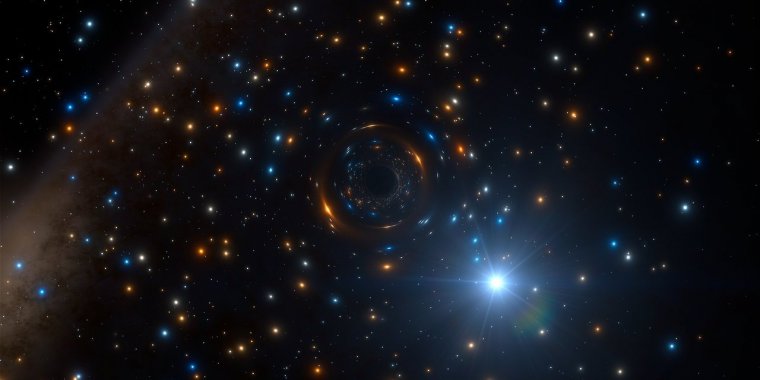| News / Science News |
Odd Behaviour of Star Reveals Lonely Black Hole Hiding in Giant Star Cluster
Astronomers using ESO’s MUSE instrument on the Very Large Telescope in Chile have discovered a star in the cluster NGC 3201 that is behaving very strangely. It appears to be orbiting an invisible black hole with about four times the mass of the Sun — the first such inactive stellar-mass black hole found in a globular cluster and the first found by directly detecting its gravitational pull.

Artist’s impression of the black hole binary system in NGC 3201. ![]()
Globular star clusters are huge spheres of tens of thousands of stars that orbit most galaxies. They are among the oldest known stellar systems in the Universe and date back to near the beginning of galaxy growth and evolution. More than 150 are currently known to belong to the Milky Way.
One particular cluster, called NGC 3201 and situated in the southern constellation of Vela (The Sails), has now been studied. An international team of astronomers has found that one of the stars in NGC 3201 is behaving very oddly — it is being flung backwards and forwards at speeds of several hundred thousand kilometres per hour, with the pattern repeating every 167 days.
The relationship between black holes and globular clusters is an important but mysterious one. Because of their large masses and great ages, these clusters are thought to have produced a large number of stellar-mass black holes — created as massive stars within them exploded and collapsed over the long lifetime of the cluster.
With this new finding, the team have for the first time been able to detect an inactive black hole at the heart of a globular cluster — one that is not currently swallowing matter and is not surrounded by a glowing disc of gas. They could estimate the black hole’s mass through the movements of a star caught up in its enormous gravitational pull.
From its observed properties the star was determined to be about 0.8 times the mass of our Sun, and the mass of its mysterious counterpart was calculated at around 4.36 times the Sun’s mass — almost certainly a black hole. (ESO)
YOU MAY ALSO LIKE




